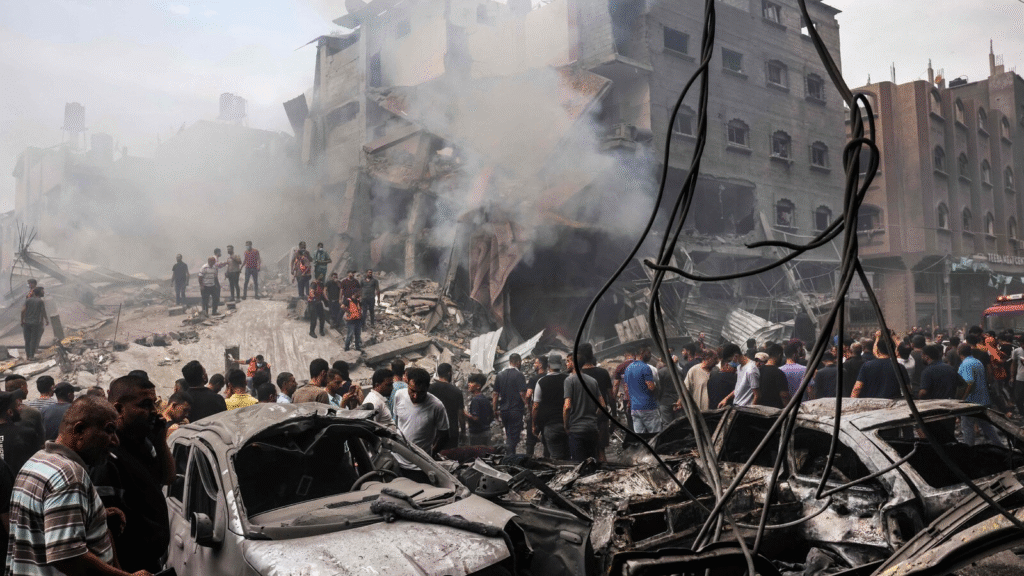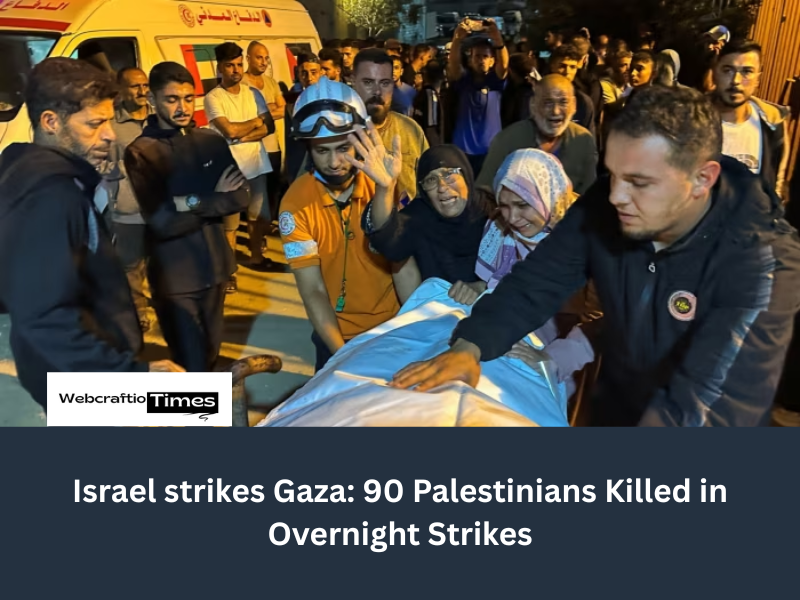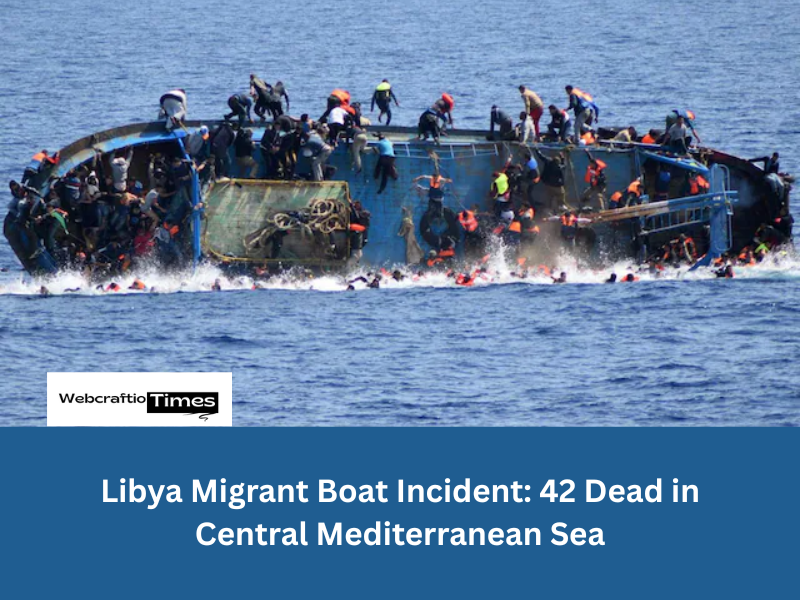The fragile US-brokered ceasefire in Gaza was shattered overnight. Latest reports confirm that at least 90 Palestinians were killed in a series of intense Israeli air raids. This wave of violence began shortly after Israeli Prime Minister Benjamin Netanyahu issued a directive. He ordered the military to execute “immediate and powerful strikes” against targets in the enclave. The escalation in hostilities severely tests the two-week-old truce. It brings the region to the brink of a complete return to full-scale conflict. Israel Strikes Gaza in a significant escalation that has drawn immediate international condemnation and concern. This entire episode has been fueled by mutual accusations of ceasefire violations. The return of deceased Israeli hostages remains a contentious and emotional point.
Ceasefire Collapse: Why Israel Strikes Gaza
The Prime Minister’s dramatic order followed a day of rapidly mounting tensions. It focused on two primary incidents. First, an Israeli military official reported that Israeli forces came under fire in the southern Gaza city of Rafah. The military accused Palestinian militants of conducting the attack. Hamas, however, completely denied any involvement in the shooting incident.
Read More: Trump Warns Israel: Annexation Means Losing All US Support
The second and more contentious issue involved the return of hostage remains. Hamas transferred remains to Israel via the Red Cross on Monday. Forensic examination revealed the remains belonged to Ofir Tzarfati. Mr. Tzarfati was a hostage killed during the October 7, 2023, attack. Crucially, Israeli forces had already recovered his body in November 2023. Israel immediately labeled this act a manipulation and a “clear violation” of the ceasefire agreement. The agreement requires the swift and honest return of all deceased captives.

Netanyahu convened an emergency security meeting. He then issued his directive for immediate and powerful military action. Defense Minister Israel Katz publicly supported the decision. He warned that the militant group would “pay a heavy price” for attacking Israeli soldiers. He also cited the manipulation of the hostage remains as a cause for the renewed military offensive.
Deadly Impact of the Attacks
The initial order for “powerful strikes” quickly translated into a heavy bombardment across the Gaza Strip. The attacks concentrated on densely populated areas. These included Gaza City, Khan Younis, and the central Nuseirat refugee camp.
Gaza’s Civil Defense Agency confirmed the high civilian casualty toll. They stated that at least 60 Palestinians died in the overnight raids. More than 20 children were reportedly among the dead. Rescue teams are currently working under dangerous conditions. They are attempting to recover the dead and wounded from beneath the immense rubble.

A spokesman for the Civil Defense Agency described the situation as “catastrophic and terrifying.” One strike hit a civilian vehicle on Al-Qassam Street in Khan Younis. Five people, including two children, were killed in that single incident. Other reported targets included residential buildings and the courtyard of the heavily damaged Al-Shifa Hospital. The civilian toll from the strikes emphasizes the severe risk facing the remaining population in the enclave.
Hostage Remains and the Broken Trust
The heart of the current crisis lies in the stalled effort to recover the remains of the deceased Israeli hostages. Under the current ceasefire terms, Hamas must return the remains of all captives. In exchange, Israel agreed to release 15 Palestinian bodies for each Israeli. Thirteen bodies reportedly remain in Gaza.
Read More: RSF Captures El-Fasher: Marking End of Army’s Control in Darfur
Hamas had earlier expressed difficulty locating all remains. They blamed the extensive destruction caused by the two-year Israeli offensive. They claim heavy machinery is necessary to navigate the deep rubble. Israeli authorities, however, argue that the militant group is intentionally stalling the process. The Israeli military released drone footage. It claimed the video showed Hamas operatives staging a fake recovery of remains for the Red Cross.
Following Netanyahu’s order to strike, the Al-Qassam Brigades, Hamas’s armed wing, issued a response. They announced a postponement of any further body handovers. The group explicitly warned that the renewed Israeli attacks would severely disrupt its search and recovery operations. They also stated the escalation would further delay the return of any other bodies.
International Response and Ceasefire Outlook
The escalation has triggered a frantic diplomatic scramble. US officials have continuously visited the region. Their mission is to shore up the extremely fragile peace deal.
US Vice President JD Vance commented on the situation. He acknowledged the violence. However, he maintained that the ceasefire was “holding” despite “little skirmishes here and there.” The US has consistently pushed both sides to uphold the truce terms. They specifically urged Hamas to return the remains and Israel to refrain from actions that could cause the ceasefire to collapse.
Turkey’s foreign ministry issued a strong statement. They called the recent Israeli strikes a “flagrant violation of the ceasefire.” The ministry expressed deep concern over the civilian deaths. They also reiterated the vital importance of full adherence to the ceasefire. Many international analysts fear that the new wave of aggression may be the event that finally terminates the agreement. The pressure on Prime Minister Netanyahu to respond forcefully to perceived violations is mounting. However, the international community is simultaneously stressing the need for calm.
The immediate outlook for the Gaza ceasefire appears bleak. The death toll from the most recent Israel strikes Gaza is substantial. This action is the most significant challenge to the truce since its implementation. Humanitarian organizations fear a total collapse of aid distribution. Residents on the ground express a deep fear that the full-scale war is about to resume.
FAQs on the Renewed Gaza Strikes
1. What triggered Prime Minister Netanyahu’s order for “powerful strikes”?
The order followed two main issues: an alleged attack on Israeli forces near Rafah, and Israel’s accusation that Hamas violated the ceasefire by manipulating the handover of partial remains of a deceased Israeli hostage whose body had already been recovered.
2. How many Palestinians were reportedly killed in the strikes following the order?
The Gaza Civil Defense Agency reported that at least 60 Palestinians were killed in the strikes, with more than 20 children reportedly among the casualties.
3. What specific part of the ceasefire agreement is under immediate threat?
The agreement’s requirement for the immediate and full return of the remains of deceased Israeli hostages is the most immediate threat. Disputes over the bodies have led to mutual accusations of truce violations.
4. How did Hamas respond to the renewed Israeli strikes?
Hamas denied responsibility for the attack on Israeli troops and announced it would postpone the planned handover of a hostage’s remains, arguing the Israeli strikes disrupt their search and recovery efforts.
5. What is the current international status of the ceasefire?
Despite the significant escalation, US Vice President JD Vance stated the ceasefire is technically “holding” but is facing its most serious test. International bodies like Turkey have condemned the Israeli strikes as a “flagrant violation.”



